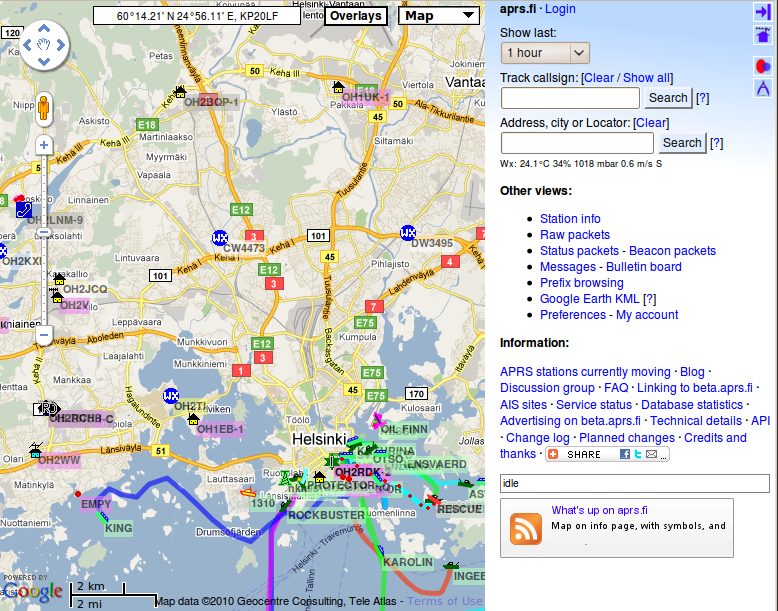Ero sivun ”Aprs.fi user guide” versioiden välillä
>Oh7lzb |
>Oh7lzb |
||
| Rivi 16: | Rivi 16: | ||
TODO: describe the '''basic''' features of the real-time map. Provide a separate page for the advanced features. | TODO: describe the '''basic''' features of the real-time map. Provide a separate page for the advanced features. | ||
The real-time map which opens up first when you arrive on the site displays, in nearly real time, APRS and AIS data on top of maps or satellite images provided by Google Maps. By default, it opens up showing the real-time situation in an area which should be relatively near your current location. It might or might not work, but usually it opens up at least in the correct country. It is possible to select and save an initial view, but more on that later! | |||
[[Tiedosto:Aprsfi Shot main.png]] | |||
==Searching for an APRS callsign or AIS vessel== | ==Searching for an APRS callsign or AIS vessel== | ||
==Searching for an address== | ==Searching for an address== | ||
==Selecting an initial default view== | |||
=Common search features= | =Common search features= | ||
Versio 29. kesäkuuta 2010 kello 18.20
This page should eventually evolve into a comprehensive user guide for the aprs.fi web service. It's still in it's early stages. This is a Wiki page, so you're welcome to expand the document!
Introduction
The aprs.fi web service collects information from the Automatic Packet (or Position) Reporting System Internet network (APRS-IS). APRS is used by amateur (ham) radio operators to transmit real-time position information, weather data, telemetry and messages over the radio. A vehicle equipped with a GPS receiver, a VHF transmitter or HF transceiver and a small computer device called a tracker transmits it's location, speed and course in a small data packet, which is then received by a nearby iGate receiving site which forwards the packet on the Internet. Systems connected to the Internet can send information on the APRS-IS without a radio transmitter, or collect and display information transmitted anywhere in the world.
In addition to that, aprs.fi also displays AIS data transmitted by most large ships. AIS transmissions are received by volunteers at numerous sites, but most areas are largely uncovered.
This guide aims to become an user guide for the aprs.fi web site, and as such does not attempt to describe the APRS or AIS systems in detail. To get started with APRS, please consult the following pages:
- Wikipedia: Automatic Packet Reporting System
- G4ILO: APRS - Putting ham radio on the map
- K9DCI: APRS Beginner Guide (PDF)
Real-time map
TODO: describe the basic features of the real-time map. Provide a separate page for the advanced features.
The real-time map which opens up first when you arrive on the site displays, in nearly real time, APRS and AIS data on top of maps or satellite images provided by Google Maps. By default, it opens up showing the real-time situation in an area which should be relatively near your current location. It might or might not work, but usually it opens up at least in the correct country. It is possible to select and save an initial view, but more on that later!
Searching for an APRS callsign or AIS vessel
Searching for an address
Selecting an initial default view
Common search features
TODO: describe callsign and wildcard lookups. TODO: describe date search field.
Info page
TODO: describe the /info/ pages.
Info graphs
TODO: describe the /info/graphs/ page.
Weather display
TODO: describe the /weather/ graphs and the weather features of the real-time map.
Telemetry
TODO: describe /telemetry/.
Preferences
TODO: describe the Preferences view.
Status packets
TODO: describe status packets view.
Beacon packets
TODO: describe beacon packets view.
Bulletin board
TODO: describe bulletins view.
